The principle of specificity is an important one for the strength and conditioning coach, but it is also one that has limitations. Traditionally specificity is defined as the body adapting to training according to how it is trained. A very simplified example is that if you want to develop bigger biceps, you are probably going to have to perform exercises that train those muscles. Relying on leg presses to increase your bicep size will probably be an exercise in frustration.
When it comes to training athletes, specificity typically applies to several aspects of training:
- Movement patterns
- Muscles and joints
- Energy systems
- Speed of movement
For reasons that I’ll cover, a lot of this sounds really good but is actually problematic to achieve in practice. The best that we can often do is to approach training in a general fashion, it’s extremely challenging to match specificity up to a sport.
Movement patterns:
It is difficult to train sport-specific movement patterns in the weight room. In fact, this can have disastrous consequences. For example, we can have baseball pitchers perform the pitching motion with a dumbbell. In a sense we are strengthening the motion to be trained. However, this approach will alter the pitcher’s mechanics leading to a less effective pitching motion, possible injury from pitching due to the change in mechanics, and possible injury to the pitching shoulder and elbow due to the increased load from the dumbbell.
The best that we can do, safely, is to approach movement patterns in a general sense. Here are some things we can look for:
- The event involves exerting force against the ground
- The event is primarily performed off one leg
- The event requires levering off one side of the body
- The event involves exerting force vertically, horizontally, or both
- The event involves rotation
- Etc.
We can develop an effective strength and conditioning program that trains the movement patterns in a general sense, but mimicking the event isn’t advisable in many situations. So, taking the pitcher as an example our strength and conditioning program can involve exercise performed standing up (we exert force against the ground), that are performed primarily off one leg (stepping forward, levering off one side to throw), that train rotation, etc.
Muscles and joints:
We can identify the muscles involved in performing the sport and design a program that trains those muscles. There are two challenges here. The first is that most of the muscles are involved in sports as prime movers, antagonists, or stabilizers. The second is that spending a lot of time isolating muscles in training has consequences.
The first consequence is that we’re strengthening the muscle in a manner that is dissimilar to how it will be used in the event. Muscles do not act in isolation during sports. For example, our pitcher is striding forward off the mound the throw the ball. In a sense they will be pulling their body forward with their front leg, which means hip extension is occurring in the front leg. Hip extension means the hamstrings and glutes. However, while this is occurring the pitcher is rotating using the hips, stabilizing the trunk, and preparing the bring the arm forward as they release the ball. So simply performing leg curls to strengthen the hamstrings is not going to be very effective at improving the athlete’s pitching performance. So this goes back to needing to focus on general movement patterns.
A second consequence is that often by focusing on individual muscles we can create or exacerbate the problems we’re seeking to avoid. For example, a lot of people with rotator cuff issues perform rotator cuff exercises because they think they need to. The challenge is that they approach this like any other exercise, load them up with weight, and (accidentally) encourage hypertrophy and inflammation in those muscles. Since there is a finite space in the shoulder, this tends to cause the very issues that people are training to avoid!
Energy systems:
Energy systems is a tough one. Ever since undergraduates take their first exercise physiology course they are taught that there are three energy systems. Movements on this duration primarily rely on this system, those that last longer rely on this other one, etc. And somewhere in the lecture a good professor will remind everyone that nothing exists in isolation and that we need the aerobic energy system to recover from everything.
When applying energy systems to sports, it’s challenging. In some cases it’s pretty straightforward. An Olympic weightlifter is going to use the phosphagen energy system. A jumper or thrower in track and field, same thing. The sprints are a little more challenging because even the 100 meter sprint is going to require input from more than one energy system.
When you get to team sports, however, things get really difficult. Soccer players may cover five or more kilometers during a game, but this distance is covered at a myriad of speeds and intensities. So what do you select to train for? How do you know that what you are programming for is ideal?
Our baseball player may throw the ball in a matter of seconds, but on average he’ll take about 18 seconds until the next pitch and he may repeat this 20-30 times in an inning.
To me this goes back to a general approach to training. Unless we’re in a sport that is easily identifiable in terms of its energy system demands, it might be better for us to develop a well-rounded athlete. For example, training that focuses on speed/power/strength is pretty well geared towards the phosphagen and glycolytic energy systems. However, the glycolytic and aerobic energy systems can be taxed with larger volumes, less rest and even conditioning workouts – we don’t need to have athletes run five miles to develop all these qualities.
Speed of movement
The idea behind velocity specificity is that the gains we make from exercise (particularly strength) are specific to the velocities that we train at. In other words, if you train very heavy but very slowly then you will be stronger at slower speeds but this may not transfer to high speed movements. If true this is a pretty important concept for training athletes, since most sports take place at high speeds.
I have a few thoughts on this topic. First, as I wrote in one of my books, the research on this topic is all over the place and it is not conclusive at all. There are a lot of bad study designs looking at this one where the “slow” group is doing a completely different training program than the “fast” group. Second, most sports take place at velocities that you cannot duplicate in the weight room. In other words, this is another example of having to focus on general training that prepares your body for the event as opposed to training that mimics the event. Finally, rather than focusing on velocity specificity per se I think it’s important to focus on knowing how to use your strength. This means learning to be explosive. It can involve the Olympic lifts or their variations, but kettlebells, plyometrics, sprints, and medicine balls work just as well.


